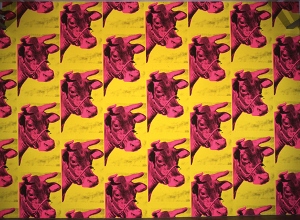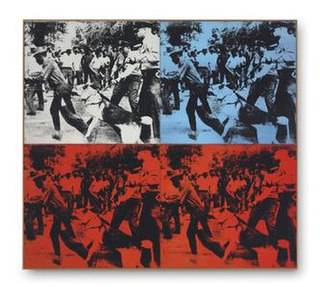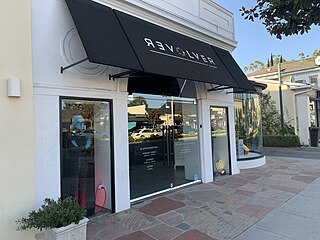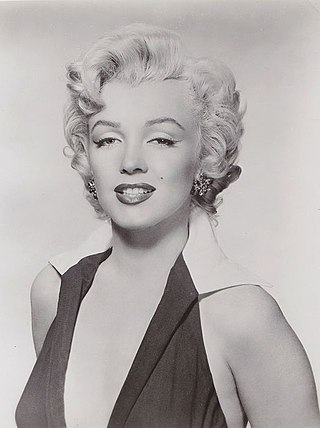Related Research Articles

Andy Warhol was an American visual artist, film director and producer. A leading figure in the pop art movement, Warhol is considered one the most important artists of the second half of the 20th century. His works explore the relationship between artistic expression, advertising, and celebrity culture that flourished by the 1960s, and span a variety of media, including painting, sculpture, photography, and filmmaking. Some of his best-known works include the silkscreen paintings Campbell's Soup Cans (1962) and Marilyn Diptych (1962), the experimental film Chelsea Girls (1966), the multimedia events known as the Exploding Plastic Inevitable (1966–67), and the erotic film Blue Movie (1969) that started the "Golden Age of Porn".

Roy Fox Lichtenstein was an American pop artist. He rose to prominence in the 1960s through pieces which were inspired by popular advertising and the comic book style. Much of his work explores the relationship between fine art, advertising, and consumerism.
Komar and Melamid is a tandem team of Russian-born American conceptualist artists Vitaly Komar and Alexander Melamid. In an artists' statement they said that "even if only one of us creates some of the projects and works, we usually sign them together. We are not just an artist, we are a movement." Both artists were born in Moscow, but emigrated to Israel in 1977 and subsequently to New York in 1978. The pair's co-authorship of works ceased in 2003–2004.
Philip Martin Pearlstein was an American painter best known for Modernist Realist nudes. Cited by critics as the preeminent figure painter of the 1960s to 2000s, he led a revival in realist art.

Campbell's Soup Cans is a work of art produced between November 1961 and June 1962 by the American artist Andy Warhol. It consists of thirty-two canvases, each measuring 20 inches (51 cm) in height × 16 inches (41 cm) in width and each consisting of a painting of a Campbell's Soup can—one of each of the canned soup varieties the company offered at the time. The works were Warhol's hand-painted depictions of printed imagery deriving from commercial products and popular culture and belong to the pop art movement.

Campbell's Soup Cans II is a work of art produced in 1969 by Andy Warhol as part of his Campbell's Soup Cans series that consists of 250 sets of 10 screenprints. This set is held by several notable museums. It differs from the preceding set of 1968 Campbell's Soup I screenprints and has variations within the series.
Deborah Kass is an American artist whose work explores the intersection of pop culture, art history, and the construction of self. Deborah Kass works in mixed media, and is most recognized for her paintings, prints, photography, sculptures and neon lighting installations. Kass's early work mimics and reworks signature styles of iconic male artists of the 20th century including Frank Stella, Andy Warhol, Jackson Pollock, and Ed Ruscha. Kass's technique of appropriation is a critical commentary on the intersection of social power relations, identity politics, and the historically dominant position of male artists in the art world.

Cow Wallpaper is a screen print by American artist Andy Warhol in 1966. Warhol created a series of four screen prints from 1966 to 1976.

Steven Alan Kaufman was an American pop artist, fine artist, sculptor, stained glass artist, filmmaker, photographer and humanitarian. His entry into the world of serious pop art began in his teens when he became an assistant to Andy Warhol at The Factory studio, who nicknamed him "SAK". Kaufman eventually executed such pieces as a 144-foot-long canvas which later toured the country.

Race Riot is a 1964 acrylic and silkscreen painting by the American artist Andy Warhol that he executed in 1964. It fetched $62,885,000 at Christie's in New York on 13 May 2014.

Orange Prince is a painting by American artist Andy Warhol of Prince, the American singer, songwriter, record producer, multi-instrumentalist, actor, and director. The painting is one of twelve silkscreen portraits on canvas of Prince created by Warhol in 1984, based on an original photograph provided to Warhol by Vanity Fair. The photograph was taken by Lynn Goldsmith. These paintings and four additional works on paper are collectively known as the Prince Series. Each painting is unique and can be distinguished by colour.

Abshalom Jac Lahav is a New York City–based artist. He is known for his series 48 Jews and The Great Americans which have been shown at museums such as Richmond Art Museum, Samuel Dorsky Museum of Art, The Oregon Jewish Museum and Jewish Museum of Florida. His painting style implements well known images of famous people in the modern contexts, but still references historical modes of painting and black-and-white photography through its use of monotone imagery. He is also the founder of the Midnight Society, an artist run curatorial project based in Brooklyn, New York.

Revolver Gallery is a Los Angeles-based art gallery with a one-artist program focused on Andy Warhol's pop art career. With over 400 Warhols in its collection, Revolver houses the largest gallery-owned collection of Andy Warhol's artwork world-wide.
Samuel Rosenberg (1896–1972) was an American artist and Professor at Carnegie Mellon University in Pittsburgh, PA. He showed his work at the Museum of Modern Art, the Whitney Museum in New York, the National Academy of Art in Washington, the Corcoran Gallery, and in the Pennsylvania Academy of Fine Arts. He was a beloved art teacher, and some of his students were Mel Bochner, Philip Pearlstein and Andy Warhol.

The Marilyn Monroe portfolio is a portfolio or series of ten 36×36 inch silkscreened prints on paper by the pop artist Andy Warhol, first made in 1967, all showing the same image of the 1950s film star Marilyn Monroe but all in different, mostly very bright, colors. They were made five years after her death in 1962. The original image was taken by Warhol from a promotional still by Gene Kornman for Monroe's film Niagara (1953).

Gold Marilyn Monroe is a screenprint painting by Andy Warhol based on a photograph of the actress Marilyn Monroe's face centered on a large gold-painted canvas. Warhol used silkscreen ink on synthetic polymer paint on canvas. It was completed in 1962, the same year as Monroe's death. The image of Monroe is a direct copy of a close-up photograph, a publicity still from her 1953 film Niagara.
Athletes is a 1977 series of silkscreen portraits by American artist Andy Warhol. Commissioned by Richard Weisman, the series consists of ten multi-colored portraits of the most celebrated athletes of the time: Muhammad Ali, Kareem Abdul-Jabbar, Chris Evert, Rod Gilbert, O.J. Simpson, Pelé, Tom Seaver, Willie Shoemaker, Dorothy Hamill, and Jack Nicklaus.
Ronald Feldman was an American art dealer and advocate for the arts, especially contemporary performance and conceptual art.

Campbell's Soup I is a work of art produced in 1968 by Andy Warhol as a derivative of his Campbell's Soup Cans series. 250 sets of these screenprints were made by the Salvatore Silkscreen Company in New York City.
Rupert Jasen Smith Jr. was an American artist. He worked closely with pop artist Andy Warhol as a silkscreen printer and art director for a decade. His association with Warhol led him to work with other artists such as Paul Jenkins, Frank Stella, and Robert Rauschenberg. Smith owned one of New York City's top printmaking studios and also held solo exhibitions of his artwork.
References
- 1 2 3 4 5 "Funny, You Don't Look Like a Subject for Warhol". New York Times . 28 March 2008. Retrieved 26 May 2019.
- ↑ "Andy Warhol 10 Portraits of Jews About". Andipa Editions. Retrieved 2023-10-11.
- ↑ Warhol, Andy; Hackett, Pat (1989). The Andy Warhol diaries. New York, NY : Warner Books. p. 223. ISBN 978-0-446-51426-2.
- ↑ Nereim, Vivian (October 20, 2010). "Ruth Eleanor Levine: Artist Known for Sense of Humor". Pittsburgh Post-Gazette. Retrieved 2023-04-25.
- ↑ Teicholz, Tom (May 30, 2019). "Warhol's 20th Century Jewish Portraits: Even His Nadir Fascinates". Forbes. Retrieved 2022-06-24.
- 1 2 3 4 5 6 7 8 9 10 "Andy Warhol Ten Portraits of Jews of the Twentieth Century Series, 1980". news.masterworksfineart.com. Retrieved 2021-10-17.
- ↑ McBee, Richard (March 23, 2008). "Warhol's Jews: Ten Portraits Reconsidered". Richard McBee Artist and Writer. Retrieved 2022-06-24.
- ↑ Kohen, Helen L. (September 5, 1980). "Is It Art? S. Florida Sees for Itself". The Miami Herald. pp. Section D.
- ↑ Kunitz, Daniel (March 20, 2008). "In Keeping With Warhol". The New York Sun. Retrieved 2022-06-24.
- ↑ Glowen, Ron (September 11, 1980). "Warhol's portraits hits Seattle". The Daily Herald. pp. 5D.
- ↑ Mershon, Helen L. (September 25, 1980). "Pop ... goes the Warhol in PCVA gallery". Oregon Journal. p. 23.
- 1 2 Kramer, Hilton (1980-09-19). "Art: Warhol Show At Jewish Museum". The New York Times. ISSN 0362-4331 . Retrieved 2021-10-17.
- 1 2 3 "Andy Warhol: 10 portraits of Jews of the 20th century". National Portrait Gallery, London . Retrieved 26 May 2019.
- ↑ "Sampler". The Hartford Courant. November 23, 1980. p. 19.
- ↑ Matilda Battersby (18 August 2011). "Andy Warhol's 'Jewish geniuses' still fuelling debate" . The Independent . Archived from the original on 2022-05-26. Retrieved 26 May 2019.
- ↑ "Jewish Museum Collection: Sigmund Freud". Jewish Museum (of New York) . Retrieved 26 May 2019.
- ↑ Rickey, Carrie (December 1980). "Carrie Rickey on Andy Warhol". Artforum. Retrieved 2023-03-19.
- ↑ Hanson, Bernard (November 23, 1980). "Grass' Sordid Pseudo-realism; Warhol's Handsome Portraits". The Hartford Courant. pp. G2.